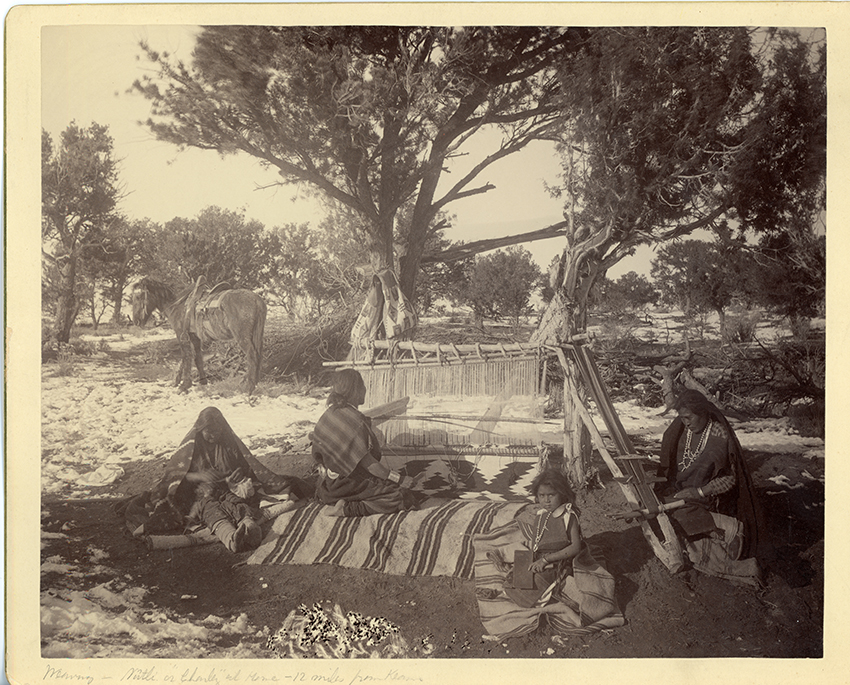LOS ANGELES — The Fowler Museum at UCLA presents 38 Nineteenth Century textiles from the Durango Collection, known for its historic Southwest weavings, in “Treasured Textiles from the American Southwest: The Durango Collection,” on view through January 10.

Third Phase chief blanket (detail shown), Diné (Navajo), 1870s; weft-faced plain weave; handspun wool in natural colors with indigo blue, raveled red trade cloth or bayeta, and commercial wool yarn. Durango Collection, Center of Southwest Studies, Fort Lewis College, Durango, Colo.
The exhibition showcases many of the collection’s signature pieces, including fine examples of the famous Diné (Navajo) First and Second Phase “chief blankets.” Among the most emblematic garments are several made by Pueblo peoples, including a Hopi boy’s blanket woven by a male relative, an indigo-dyed twill-woven Zuni woman’s dress and a man’s embroidered shirt from Jemez pueblo.
Historical photographs from the period offer visitors insights into the lives and artistic techniques of the weavers who created these textile masterworks. The exhibition traces the emergence of three great weaving traditions that developed in the highly contrasting landscapes of the Southwest. The history began more than 1,000 years ago with the ancestral Puebloans (also known as the Ancient Ones, or the Anasazi), who worked with native cotton on an upright loom.
In the 1500s, the Spanish entered the Southwest, introducing sheep and the horizontal treadle loom to the region. The Diné (Navajo) did not weave when they migrated into the Dinétah, the Navajo homeland, sometime prior to 1500. By the 1700s, however, they became skilled weavers trading prized textiles across the Southwest. By the Nineteenth Century, weavers from all three groups —Pueblo peoples, Diné (Navajo) and Hispanic settlers — were producing fine works of art, influencing one another while developing their own characteristic, mature styles. All of these rich and vital textile traditions persist to the present day.

Second Phase chief blanket, Diné (Navajo), 1860s–1870s; weft-faced plain weave or tapestry weave; handspun wool weft, handspun Churro wool in natural white and brown, indigo-dyed blue, and raveled red bayeta weft. Durango Collection, Center of Southwest Studies, Fort Lewis College, Durango, Colo.
The Diné (Navajo) works are notable for their early dating such as the aforementioned First and Second Phase “chief blankets.” One Diné (Navajo) blanket comes complete with the story of the US Army officer who used it as part of his military equipment. The oldest textile in the exhibition, a Saltillo serape dating to 1800, shows the intricate diamond patterning that later served as a source of inspiration for Diné (Navajo) “eyedazzler” weavings, while other early Hispanic serapes with subtle striped patterning, resonate with Pueblo and Diné (Navajo) styles of the same period.
These and other examples illustrate how closely entwined the three traditions became as they flourished side-by-side in the Nineteenth Century Southwest.
Most of the textiles in the Durango Collection date from about 1860 to 1880, a time of tremendous change with the coming of the US military, settlers from the Eastern states, the railroads and new trade opportunities. Despite the different experiences of the three cultural groups, their weavings reveal a continual exchange of materials, techniques and ideas. The historical import of these works and their artistry and workmanship, which remain highly regarded today, make these textiles true treasures of the American Southwest.
The Durango Collection is a comprehensive grouping of textiles and related items that represent 800 years of weaving in the American Southwest. It is part of the museum collections at the Center of Southwest Studies, Fort Lewis College, in Durango, Colo., and was assembled by Mark Winter, owner of the historic Toadlena Trading Post in New Mexico and by the late H. Jackson Clark, founder of Toh-Atin Gallery in Durango. A portion of the collection was later acquired by Richard and Mary Lyn Ballantine of Durango, who in the late 1990s, along with Mark Winter and his family, donated it to Fort Lewis College.

“Weaving — Nûtli or ‘Charlie’ at home — 12 miles from Keams,” James Mooney, circa 1890. Washington Matthews Collection, Wheelwright Museum of the American Indian, Santa Fe.
“Treasured Textiles” has been adapted by the Fowler Museum and the Museum at the Center of Southwest Studies from the exhibition “Masterpieces of the Durango Collection: Native Blankets from the Early American Southwest,” developed by the Center of Southwest Studies at Fort Lewis College in partnership with the Wheelwright Museum of the American Indian, Santa Fe, N.M.
The Fowler Museum, part of UCLA Arts, is in the north part of the UCLA campus. Admission is free. For more information, www.fowler.ucla.edu or 310 825-4361.
Gallery







